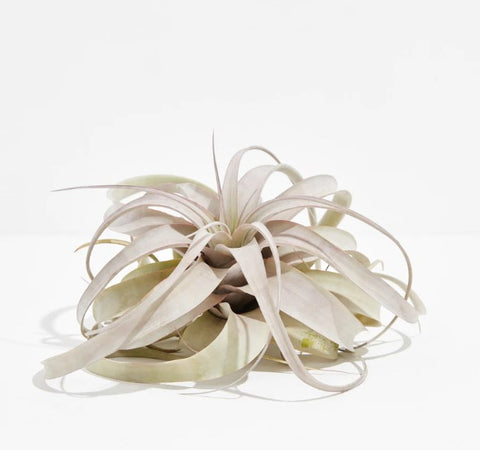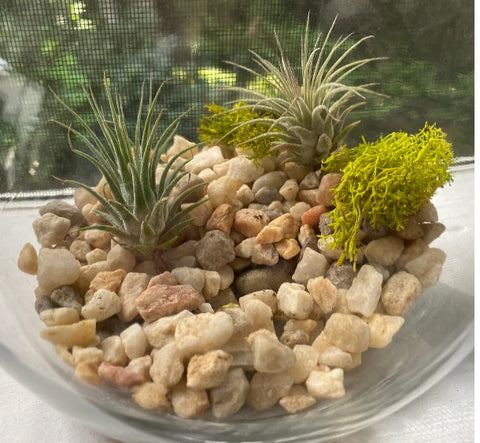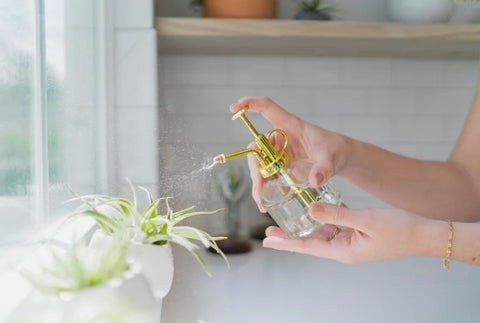How to Care for Air Plants: A Guide to Thriving Soil-free Wonders
Air plants are fascinating botanical wonders found in the forests, deserts, and mountains of North and South America.
Unlike most plants, they don't need soil to grow. Instead, they get their moisture and nutrients from the air, water, and bits of organic debris around them. Because of their unique looks and easy-care requirements, they have become quite popular among people who love plants, whether they're experienced or novice indoor gardeners.
So, if you’ve just got a gorgeous air plant and want to learn more about its growing needs, you’ve come to the right place. This guide will show you how to care for air plants, so they can thrive and make you happy.
What Is an Air Plant?

An air plant (Tillandsia) is an evergreen, perennial flowering plant from the Bromeliaceae family. It is native to Central and South America, and can be found in the southern states of the USA.
As the name hints, an air plant doesn’t require any soil to thrive and blossom. Instead, it absorbs all the nutrients and water it needs from the air and its surroundings. Its silvery leaves are covered with special water-absorption cells (trichomes.)
Furthermore, air plants photosynthesize differently from other plants; they release oxygen at night, making them great natural air-purifiers.
There are many varieties of air plants to choose from, such as Butzil, Silver Queen, Velutina, Funckiana air plants, and more. They are not only stunning to look at but also pet-friendly and non-toxic to people, too.
Tillandsia Air Plants in Bloom: All You Need to Know
Tillandsia air plants flower once in their lifetime and it may take up to 3 years to produce their stunning blooms. Depending on the variety, the color of their flowers can range from pinkish, through bright red to purple.
How Do You Encourage Air Plants to Flower?
You can encourage air plants to flower by providing them with optimal care, including bright, indirect sunlight, regular watering, medium to high humidity, a 60°F-90°F temperature range, and nutrients.
What Happens to an Air Plant After It Flowers?
An air plant produces offsets, known as “pups” after it flowers. These baby air plants emerge from the base of the main plant and can be separated once they grow about one-third to half the size of the mother plant.
Although the mother plant dies soon after this, the life cycle of the plant continues by propagating the pups.
How to Care for an Air Plant: The A to Z Guide

Air plants are straightforward to care for, as long as you understand their specific needs. Read on to find out about the intricacies of their watering and feeding requirements, as well as how to propagate them and prevent some common issues with these soil-free botanical beauties.
How to Water Air Plants
As air plants don’t require soil, as a growing medium, their water needs are sufficed differently, when compared to other houseplants. The two ways to water air plants are the soaking method and the misting technique. Let’s discuss each of these in detail.
For the soaking method, fill a sink or glass bowl with rainwater, aquarium water, or tap water, after leaving it overnight in an open container so that any chlorine dissipates.
Let the air plants sit in the water for 30 to 60 minutes. Take them out once done, and dry them completely. For this, either turn each air plant upside down on a clean cloth or a paper towel to drain excess moisture or run a small fan on a low setting in front of the plant to dry it off.

If you would rather hydrate your air plants by misting them, the proces is very easy. Just fill up a spray bottle or mister with water, as described in the soaking technique, and mist the plants a few times a week with it. El Mejor Spanish Moss is an air plant variety that is especially fond of being misted rather than soaked.
Whatever method you choose, beware that you need to protect the flower when watering a blooming air plant. You should avoid wetting the flower to avoid shortening its bloom period. The general rule of thumb is to hold the plant when soaking its delicate leaves and keep its flower above the water level. During a misting session, simply cover the bloom with your hand.
How Often Do You Water an Air Plant?
How often to water an air plant primarily depends on its variety. For instance, Xeric air plants require less frequent soaking, as they have adjusted to growing in dry climates. On the other hand, Mesic air plants enjoy high humidity, so they may need soaking more often. In addition, note that generally air plants require watering at least once a week. Also, consider giving them a good soak for a couple of hours every 2 to 3 weeks.
Can You Overwater an Air Plant?
Yes, you can overwater an air plant and the tell-tale signs are rotting leaves, turning black, right at the base of the plant, which can fall easily. You’ll spot straight away a decline in your beloved plant's overall health. Other signs of overwatering an air plant include soft yellowing leaves and mushy roots.
Light Requirements: How Much Light Do Air Plants Need?
Air plants can stay healthy for a long time if you provide them with bright but filtered light, especially in the hot summer months. They can tolerate a little bit of direct sunlight during the winter when the sun rays are much weaker.
On average, a few hours of bright, indirect sunlight is enough to keep air plants thriving and cheerful.
Should Air Plants Be in Direct Sunlight?
No, air plants shouldn’t be in direct sunlight, as we've already mentioned. The harsh rays of the sun can easily burn their delicate leaves. Overexposure to sunlight will lead to many brown spots all over them.
Still, some air plant varieties can tolerate direct sunlight, like the Xerographica, due to its thicker leaves.
Can Air Plants Live in Low Light?
Air plants do not feel happy in low-light conditions. Dark and shady spots aren’t their natural habitat. One main reason behind these plants being so light-hungry is the fact that they grow on trees and other large plants. Thus, they are naturally used to indirect light.
Air Plants: Temperature and Humidity

Air plants grow well in humid conditions with temperatures varying from 60°F to 90°F. Thus, standard indoor environments are just fine for them to thrive.
Keep these soil-free tropical wonders happy by misting them frequently to maintain high-humidity levels. This also makes bathrooms with windows, laundry rooms, and kitchens the ideal place for growing air plants at home.
How Cold Can Air Plants Survive?
Anything below 45°F or 60°F is dangerously cold for air plants. They will most likely die if exposed to such low temperatures for a prolonged period. After all, they originate from tropical regions where the nights are never too cold and frost never sets in.
Air Plant Food: How to Fertilize Tillandsia Air Plant
As we’ve already established, Tillandsia air plants thrive without soil, absorbing nutrients and minerals from the air through their leaves, in the form of dust and other organic airborne particles.
Still, this doesn’t mean that you should not give them some extra plant food to help them flourish and produce their much-desired blooms.
Dilute orchid plant food to half-strength, or employ ready-to-use solutions available online. Mist the plant generously with this solution, ensuring its leaves are coated but not soaked. Fertilize your air plant once a month during the blooming season, in early spring and summer, and reduce the frequency to once every two months during the rest of the year.
As your plant prepares to blossom, ease off on fertilizing it to prevent overfeeding.
Pro Tip: It's better to under-fertilize than to overdo it. Remember, moderation is key when feeding air plants, or any other houseplants that you might have, for that matter.
As a rule, keep an eye on your plant's growth and adjust your feeding routine accordingly. With proper care, your air plant will flourish, displaying vibrant colors and producing beautiful blooms.
Do Air Plants Need to Be Pruned?
Like other indoor plants, air plants also need to be pruned. It’s a good idea to trim these plants once a year and remove dead and yellowing leaves, as well as spent blooms. However, try to be very gentle when handling this fragile plant. Use sterilized scissors and trim damaged leaves all the way down to the plant’s base, leaving only the healthy leaves. This will encourage healthy new growth and prevent any rot from spreading.
Browning tips on a mature and declining mother plant can be trimmed safely, too, giving your whole air plant and its new babies a much tidier appearance. You can give your botanical friend a good soak in water, afterwards, to help it recover from stress.
Do You Cut Dead Flowers of Air Plants?
Dead flowers of air plants should indeed be cut off. This will not only help your air plant look more attractive but also encourage the new offsets (pups) to grow thicker and fuller at a faster rate.
How to Propagate Air Plants?
Division of the offsets (or pups) is by far the easiest technique to multiply air plants.
As the main plant matures, it produces offsets, otherwise called “pups,” at its base. Once an offset has grown to at least half the size of the mother plant, pinch it with your fingers, and gently twist it anti-clockwise. Keep rotating the plant till you completely pull it off the parent plant.
Tip: Be as gentle as you can while separating the offsets from the main plant to ensure no damage to either of them.
Repeat this process for the remaining baby air plants.
Place these pups on a flat surface and let them grow like any other air plant under optimal conditions.
Common Air Plant Issues
Air plants, like other indoor plants, are prone to several issues. These include:
- Rot: If you leave your air plant in water for too long, or forget to shake out the excess moisture from its foliage, it may start to rot. The solution is to let your plant dry out a little before placing it back to where it grows, be it a glass bowl, seashell or next another plant.
- Brown tips: Air plants can develop brown tips if exposed to unfiltered, direct sunlight. Lack of sufficient moisture is another reason behind this issue. Consider reducing the light exposure and giving your plant a little more consistent hydration to bring it back to health.
- Wilting plant: Underwatering, lack of or too much light, and poor air circulation can cause your plant to dry or droop. Ensure optimal conditions for your air plant to thrive by maintaining a consistent care routine and providing suitable environmental conditions.
- Yellowing leaves: Excess sunlight, overfertilization, copper poisoning, and too much water can make your Tillandsia turn yellow. Adjust your care practices to help it recover.
- Brown spots on leaves: If you notice brown spots on your air plant’s leaves, it’s probably due to sunburn, pests, stress, or over-fertilizing. Again, do your best to remedy the problem by making the right changes. You can safely trim the brown tips, as advised earlier.
Air Plants Care: FAQs
Q: Do air plants go dormant in winter?
A: Yes, air plants do go dormant in the winter. During this phase, they won’t require as much water. Just give your Tillandsia a good misting every couple of weeks, ensuring it doesn’t dry completely.
Q: What is the best thing to put air plants in?
A: Air plants can adapt to anything you put them in. You can place them in a tiny container with a magnet, shallow bowl, or vase filled with rocks or sand, or simply tie them to driftwood with a translucent fishing line. A macrame air plant hanger is also a great option to add style to any room.
Q: Why are the tips of my air plant brown?
A: Your air plant’s tips may have turned brown due to excess exposure to direct sunlight or underwatering. Shift your green companion to another place that receives bright, but indirect light and hydrate it regularly.
Q: Can air plants survive in a bathroom?
A: Yes, air plants can survive in a bathroom, provided there’s a window for access to filtered light.
Q: How long do air plants live?
A: Air plants typically enjoy a lifespan of 2 to 5 years. But this varies, depending on the type of air plant and the level of care it receives.
Q: Is my air plant dead?
A: One way to know if your air plant is dead or not is by removing its dead leaves by gently tugging at them. If all the leaves come off easily or fall apart completely, then, your plant is most likely dead. In addition, you may notice that the color of your air plant has changed - it looks dull and brownish; it also feels soft and mushy to the touch.
Conclusion
Taking care of air plants is not so hard and definitely a rewarding experience. They flourish with just a touch of attention, needing occasional misting, consistent indirect sunlight, and a cozy, humid atmosphere like many other houseplants. Don't forget to water or soak them routinely and ensure they enjoy good air circulation to support their vibrant growth.
As for display ideas, the best option is to hang these soil-free plants in glass terrariums, place them in decorative shells, or mount them on driftwood. Get creative with your arrangements to showcase these unique plants in your home or office space.
To spruce up your indoor garden even more, consider growing companion plants like cacti and bromeliads together with your Tillandsias.













Leave a comment